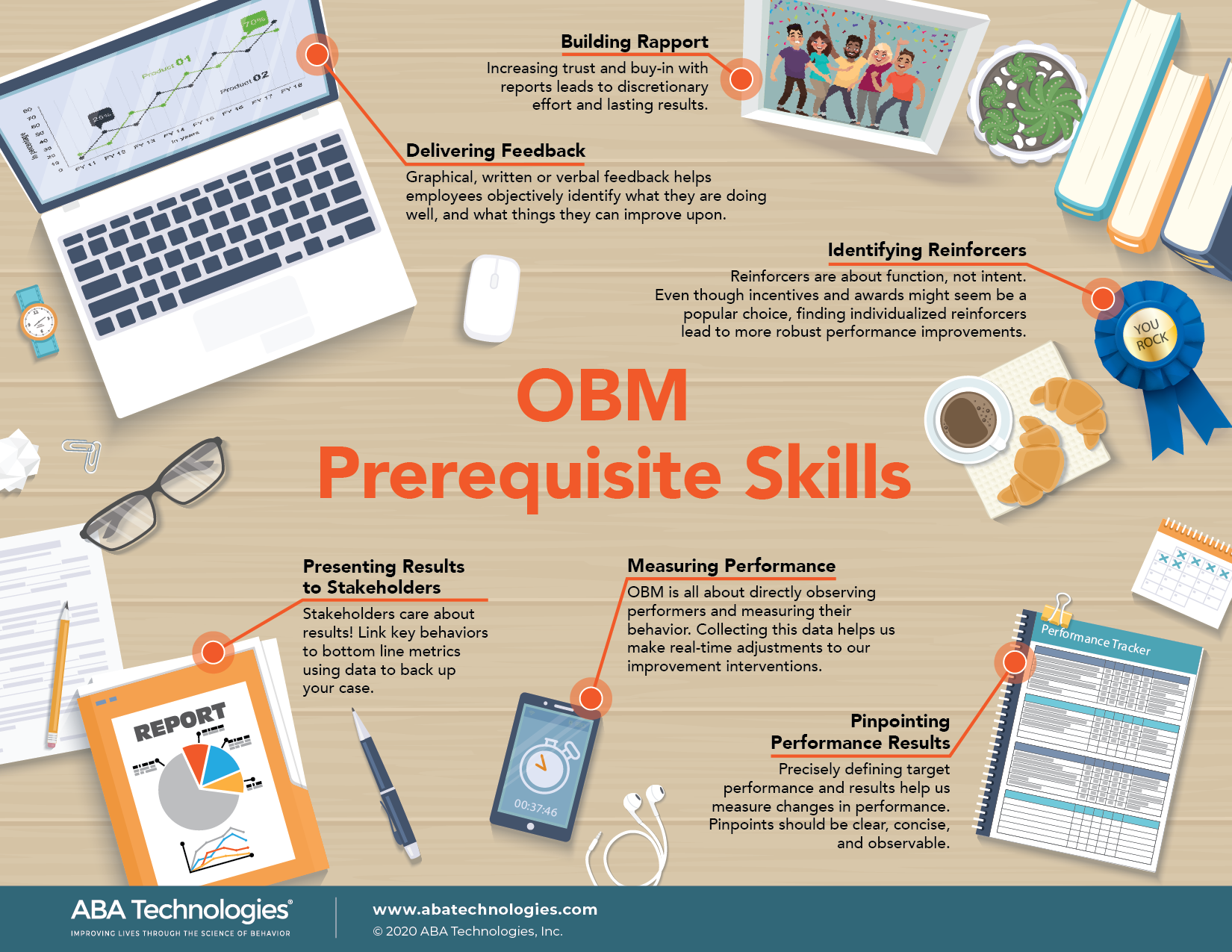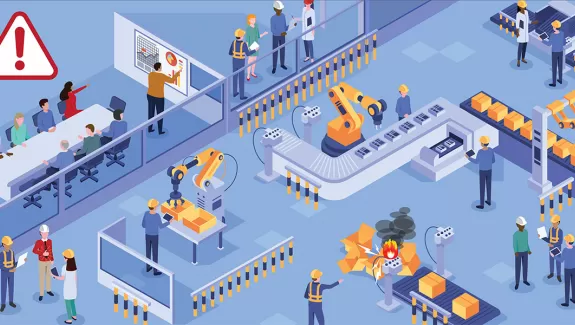
OBM Prerequisite Skills
Author: Vincent Bello
Part 1 of 7
OBM Prerequisite Skills
Organizational behavior management (OBM) is a growing field that is bringing the science of behavior to the business world. “OBMers” have demonstrated over the last several decades that a science-based approach to increasing employee performance leads to powerful organizational results. These results have been well documented throughout the specialty areas of OBM.
In this series, we will take a closer look at each of these areas of professional OBM practice. Critical skills required in each area will be illustrated and discussed through weekly infographics and blogs. We will also be providing information to help you in your job search for OBM jobs in the business world. Searching for OBM jobs might be difficult at first, as many businesses don’t call their positions OBM. Instead, businesses have a variety of job titles across each area of practice that OBMers could be qualified for. Throughout each infographic/blog pair, we will be sharing a list of job titles and requirements that align with each of the five areas of OBM practice, pulling directly from job descriptions posted by some of the most innovative companies in the world (including Google, Amazon, top consulting firms, and government agencies).
In this blog, we will be taking a deeper look at OBM prerequisite skills: skills that you can develop through your graduate training or professional development that provide the foundation for professional practice. Acquiring these foundational skills is the first step in changing behavior in the workplace and obtaining bottom-line results. Note that this is not a full list of every skill that OBMers should acquire, just the basics that give you a good start before focusing on a more specialized area.
One final note: remember that as an OBMer, you are first and foremost a behavior analyst. This means that no matter what area of practice you are interested in, your job is to identify how environmental variables in the workplace influence behavior. Conducting a behavioral analysis involves identifying relevant antecedents and consequences and then changing them to improve targeted behavior. Everything we do as behavior analysts is dependent on context, so at the end of the day, OBM is all about applying these basic skills and procedures to fit your specific workplace.
Building Rapport
 Building rapport means developing collaborative relationships with clients and refers to a variety of individual behaviors. Rapport building can include verbal behavior, such as asking others open-ended questions to learn more about their ideas and making positive comments that show that the individual’s ideas are valued. Non-verbal behaviors that can build rapport include nodding while someone is speaking, smiling, and making eye contact. By engaging in rapport-building behaviors early on, it has been suggested that direct reports and stakeholders are more likely to “buy-in” to performance improvement strategies and provide support throughout the process. These suggestions have been a topic of recent research in OBM. For example, Curry et al. (2019) found that building rapport with direct reports prior to a work task increased productivity and discretionary effort. The discretionary effort involves clients engaging in target behaviors not because they are being told to do so, but because those behaviors work and help them contact reinforcement. As most things do in OBM, skills such as building rapport come down to contingencies of reinforcement which is the first and last step in producing valuable behavior change.
Building rapport means developing collaborative relationships with clients and refers to a variety of individual behaviors. Rapport building can include verbal behavior, such as asking others open-ended questions to learn more about their ideas and making positive comments that show that the individual’s ideas are valued. Non-verbal behaviors that can build rapport include nodding while someone is speaking, smiling, and making eye contact. By engaging in rapport-building behaviors early on, it has been suggested that direct reports and stakeholders are more likely to “buy-in” to performance improvement strategies and provide support throughout the process. These suggestions have been a topic of recent research in OBM. For example, Curry et al. (2019) found that building rapport with direct reports prior to a work task increased productivity and discretionary effort. The discretionary effort involves clients engaging in target behaviors not because they are being told to do so, but because those behaviors work and help them contact reinforcement. As most things do in OBM, skills such as building rapport come down to contingencies of reinforcement which is the first and last step in producing valuable behavior change.
Pinpointing
![]() Pinpointing is all about specifically describing the target behavior and target results that you want to change. Pinpointing behavior into clearly observable, specific, and measurable terms allows you to track performance and identify improvements when they occur. If you can’t directly observe the behavior or measure it, how can we tell if performance is moving in the right direction? Pinpointing is one critical skill that distinguishes OBMers from the rest of the pack, as many other performance interventions rely on vague descriptions of target performance. Managers frequently attribute productivity problems to subjective causes, such as “poor attitudes,” “poor work ethic,” or “laziness.” These are all unreliable descriptions of behavior because they don’t tell us specifically what is happening. What does the poor attitude look like? How can you measure laziness? When describing behavior, OBMers use pinpoints that are specific, reliable, objective, and observable so that there is no question of what exactly is being measured. Saying that an employee “completes all assigned tasks with 100% accuracy at least one hour before a deadline” tells us a lot more about behavior than saying that the employee is “hardworking.” Pinpointed results are specific metrics produced by a pinpointed behavior or “what is left over” after the behavior has occurred. Pinpointed results tell us how the changes in pinpointed behaviors are changing organizational productivity. Linking pinpointed results will be discussed in more detail under “presenting results to stakeholders.”
Pinpointing is all about specifically describing the target behavior and target results that you want to change. Pinpointing behavior into clearly observable, specific, and measurable terms allows you to track performance and identify improvements when they occur. If you can’t directly observe the behavior or measure it, how can we tell if performance is moving in the right direction? Pinpointing is one critical skill that distinguishes OBMers from the rest of the pack, as many other performance interventions rely on vague descriptions of target performance. Managers frequently attribute productivity problems to subjective causes, such as “poor attitudes,” “poor work ethic,” or “laziness.” These are all unreliable descriptions of behavior because they don’t tell us specifically what is happening. What does the poor attitude look like? How can you measure laziness? When describing behavior, OBMers use pinpoints that are specific, reliable, objective, and observable so that there is no question of what exactly is being measured. Saying that an employee “completes all assigned tasks with 100% accuracy at least one hour before a deadline” tells us a lot more about behavior than saying that the employee is “hardworking.” Pinpointed results are specific metrics produced by a pinpointed behavior or “what is left over” after the behavior has occurred. Pinpointed results tell us how the changes in pinpointed behaviors are changing organizational productivity. Linking pinpointed results will be discussed in more detail under “presenting results to stakeholders.”
Measuring Performance
 Once you have pinpointed behaviors, the next step is observing and measuring that behavior. Direct observation of behavior is at the core of applied behavior analysis. Measuring performance involves recording data based on your observations. Observations can take place in multiple ways from walking around the workplace floor and watching performers naturalistically, to conducting more structured individual performance assessments. Time, resources, and other factors influence how often and for how long observations can take place. To make the most out of performer observations, OBMers benefit by planning each observation session and coordinating with stakeholders to provide support during these times. OBMers can measure behavior in several ways, including rate, frequency, duration, latency, and more. Rate is a common dimension of behavior and is measured by counting how many times the target behavior occurs and dividing that number by the amount of time that the behavior was observed. Rate can tell us how many calls a sales agent makes each hour or how many parts are manufactured in a week. Duration is also a common dimension of behavior and is measured by recording the amount of time a behavior occurs. Duration can tell us how many minutes an employee spends talking on the phone with a client or even how long an employee spends talking with co-workers in the break room. Rate, duration, and other measurements each describe behavior in different ways; therefore, it is important that you use the measurement that is most appropriate for the target performance. OBMers often take their observations and measurements a step further by graphing their data. Graphs are another core element of applied behavior analysis and allow for visual inspection of behavior change over time.
Once you have pinpointed behaviors, the next step is observing and measuring that behavior. Direct observation of behavior is at the core of applied behavior analysis. Measuring performance involves recording data based on your observations. Observations can take place in multiple ways from walking around the workplace floor and watching performers naturalistically, to conducting more structured individual performance assessments. Time, resources, and other factors influence how often and for how long observations can take place. To make the most out of performer observations, OBMers benefit by planning each observation session and coordinating with stakeholders to provide support during these times. OBMers can measure behavior in several ways, including rate, frequency, duration, latency, and more. Rate is a common dimension of behavior and is measured by counting how many times the target behavior occurs and dividing that number by the amount of time that the behavior was observed. Rate can tell us how many calls a sales agent makes each hour or how many parts are manufactured in a week. Duration is also a common dimension of behavior and is measured by recording the amount of time a behavior occurs. Duration can tell us how many minutes an employee spends talking on the phone with a client or even how long an employee spends talking with co-workers in the break room. Rate, duration, and other measurements each describe behavior in different ways; therefore, it is important that you use the measurement that is most appropriate for the target performance. OBMers often take their observations and measurements a step further by graphing their data. Graphs are another core element of applied behavior analysis and allow for visual inspection of behavior change over time.
Delivering Feedback
 Feedback is specific information that describes current performance in relation to a performance goal. The effects of feedback on performance has been widely researched in OBM. This research suggests that multiple parameters of feedback delivery influence how effective it will be. First, the modality—form of feedback—is important. Studies have shown that the greatest improvements in performance can be obtained using a combination of graphic, verbal, and written feedback. Graphical feedback helps to illustrate trends in performance which helps employees identify how their performance is changing over time. With all three modalities of feedback, it is critical that the data regarding performance is objective. In other words, the data you share with your reports must represent observable behavior, not a subjective interpretation of performance. Subjective feedback can often come off as accusatory or opinionated which could lead to a lack of trust in your reports. Feedback should also be delivered frequently. This provides the performer with more opportunities to monitor their performance and make timely adjustments in areas that are not changing as intended. Finally, feedback should be specific. This requires that the performance being discussed is operationalized and described completely. This also includes describing the exact changes in the duration, frequency, latency, or other dimensions you are using to measure performance. When feedback is frequent, objective, specific, and immediate, it helps performers identify exactly what they need to do in order to achieve their goals. Meeting these goals is critical to the future performance of the employee and the organization. (Technical note: Feedback can function as both an antecedent and consequence. When feedback is delivered after behavior occurs and increases or decreases that behavior in the future, it functions as a consequence intervention. However, the same feedback interaction can also function as task clarification that evokes the desired response, thus functioning as an antecedent.)
Feedback is specific information that describes current performance in relation to a performance goal. The effects of feedback on performance has been widely researched in OBM. This research suggests that multiple parameters of feedback delivery influence how effective it will be. First, the modality—form of feedback—is important. Studies have shown that the greatest improvements in performance can be obtained using a combination of graphic, verbal, and written feedback. Graphical feedback helps to illustrate trends in performance which helps employees identify how their performance is changing over time. With all three modalities of feedback, it is critical that the data regarding performance is objective. In other words, the data you share with your reports must represent observable behavior, not a subjective interpretation of performance. Subjective feedback can often come off as accusatory or opinionated which could lead to a lack of trust in your reports. Feedback should also be delivered frequently. This provides the performer with more opportunities to monitor their performance and make timely adjustments in areas that are not changing as intended. Finally, feedback should be specific. This requires that the performance being discussed is operationalized and described completely. This also includes describing the exact changes in the duration, frequency, latency, or other dimensions you are using to measure performance. When feedback is frequent, objective, specific, and immediate, it helps performers identify exactly what they need to do in order to achieve their goals. Meeting these goals is critical to the future performance of the employee and the organization. (Technical note: Feedback can function as both an antecedent and consequence. When feedback is delivered after behavior occurs and increases or decreases that behavior in the future, it functions as a consequence intervention. However, the same feedback interaction can also function as task clarification that evokes the desired response, thus functioning as an antecedent.)
Identifying Reinforcers
 It is clear to all OBMers that delivering reinforcement for targeted behavior drives performance in the desired direction. What is less clear is which specific reinforcers should be used to achieve the greatest performance improvements. Many managers may turn to generic monthly awards or public praise during weekly meetings. Just because these reinforcers are widely used, doesn’t mean they are the most effective for every employee. Reinforcers are about function, not about intent. In other words, just because we think something will be reinforcing doesn’t mean it will actually increase performance. Figuring out what is reinforcing for each individual and what is not will help you precisely control behavior and increase performance efficiently. This can be done in a few ways, the easiest being asking performers what they like. Some employees might tell you that a brief email thanking them for a job well done is more reinforcing than publicly praising them during a meeting. Check back in for the Performance Management blog for more on delivering reinforcement.
It is clear to all OBMers that delivering reinforcement for targeted behavior drives performance in the desired direction. What is less clear is which specific reinforcers should be used to achieve the greatest performance improvements. Many managers may turn to generic monthly awards or public praise during weekly meetings. Just because these reinforcers are widely used, doesn’t mean they are the most effective for every employee. Reinforcers are about function, not about intent. In other words, just because we think something will be reinforcing doesn’t mean it will actually increase performance. Figuring out what is reinforcing for each individual and what is not will help you precisely control behavior and increase performance efficiently. This can be done in a few ways, the easiest being asking performers what they like. Some employees might tell you that a brief email thanking them for a job well done is more reinforcing than publicly praising them during a meeting. Check back in for the Performance Management blog for more on delivering reinforcement.
Presenting Results to Stakeholders
 OBMers provide value to the organizations they work with by demonstrating that their behavior-change procedures have produced organizational improvements. Obtaining these results is not the final step; your results must be shared with stakeholders. A stakeholder is any individual in the organization who is affected by the intervention results. This is a broad description, but a stakeholder could include managers, supervisors, senior leadership, or even other employees. Stakeholders are those who have some responsibility for producing organizational results and generally prioritize bottom-line improvements over anything else. Abernathy (2008) identified seven critical bottom-line results that stakeholders prioritize in business settings. These key performance indicators (KPIs) include sales, expenses, productivity, cash flow, regulatory compliance, customer service, and special projects. OBMers gain credibility by showing that their interventions produced improvements in one or more of these KPIs. Do not expect stakeholders to be interested in the science behind OBM procedures, but you can be sure they will be more than happy to hear that your interventions saved them time and money.
OBMers provide value to the organizations they work with by demonstrating that their behavior-change procedures have produced organizational improvements. Obtaining these results is not the final step; your results must be shared with stakeholders. A stakeholder is any individual in the organization who is affected by the intervention results. This is a broad description, but a stakeholder could include managers, supervisors, senior leadership, or even other employees. Stakeholders are those who have some responsibility for producing organizational results and generally prioritize bottom-line improvements over anything else. Abernathy (2008) identified seven critical bottom-line results that stakeholders prioritize in business settings. These key performance indicators (KPIs) include sales, expenses, productivity, cash flow, regulatory compliance, customer service, and special projects. OBMers gain credibility by showing that their interventions produced improvements in one or more of these KPIs. Do not expect stakeholders to be interested in the science behind OBM procedures, but you can be sure they will be more than happy to hear that your interventions saved them time and money.
References
Abernathy, W., B. (2008). Implications and applications of a behavior systems perspective. Journal of Organizational Behavior Management, 28, 123–138. doi:10.1080/01608060802100980.
Goleman, D. (2000). Leadership That Gets Results. Harvard Business Review, 78(2), 78.
 OBM Prerequisite Skills
OBM Prerequisite Skills
OBM prerequisite skills: skills that you can develop through your graduate training or professional development that provide the foundation for professional practice.














